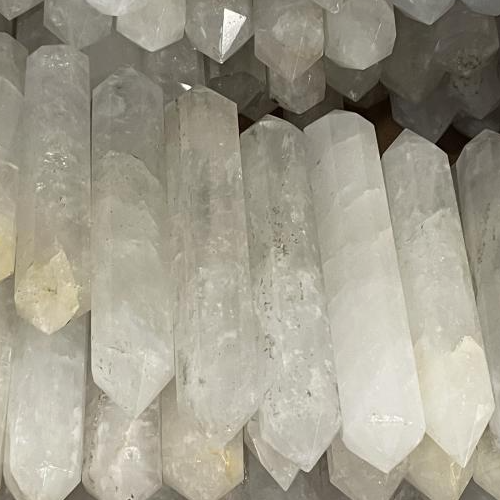Product Description
Quartz Tibetan Double Terminated 3"
Mineral Information:
Tibetan quartz, also known as Tibetan black quartz or Himalayan quartz, is a type of quartz crystal that is found in the Himalayan mountain regions of Tibet and Nepal. It is known for its distinctive appearance and unique energetic properties. Here are some key features and characteristics of Tibetan quartz:
Color and Appearance: Tibetan quartz can come in various colors, including clear, smoky, or a combination of both. It often exhibits unusual inclusions, such as black or brownish iron oxide, carbon, or other minerals. These inclusions give Tibetan quartz a distinct and captivating appearance, sometimes resembling skeletal or phantom formations.
Clarity and Transparency: Tibetan quartz crystals can range from transparent to translucent, with some specimens displaying semi-translucent or milky areas due to inclusions or internal veils. The transparency and clarity of Tibetan quartz can vary from specimen to specimen.
Metaphysical Meaning:
Tibetan quartz is highly regarded for its energetic and metaphysical properties. It is believed to carry the ancient wisdom and spiritual energy of the Himalayan mountains. Tibetan quartz is associated with spiritual growth, transformation, and inner healing. It is often used for meditation, energy work, and enhancing spiritual practices. Many people find that Tibetan quartz has a grounding yet uplifting energy, facilitating connection to higher consciousness and spiritual realms.
Mineral Care:
Tibetan quartz, like other varieties of quartz, is generally considered to be a relatively durable and tough mineral. However, it is not entirely immune to damage, and some factors can affect its fragility. Here are a few considerations regarding the fragility of Tibetan quartz:
-
Hardness: Quartz, including Tibetan quartz, has a hardness of 7 on the Mohs scale. This means it is relatively hard and can withstand normal wear and tear. Its hardness makes it resistant to scratching by most common objects. However, it is important to note that even though Tibetan quartz is relatively hard, it can still be scratched by materials with a higher hardness, such as corundum (including sapphires and rubies) or diamond. Therefore, it is best to avoid contact with harder substances to prevent scratches.
-
Inclusions and Fractures: Tibetan quartz crystals often exhibit unique inclusions, such as black or brownish iron oxide, carbon, or other minerals. These inclusions can add beauty and character to the crystal but may also introduce areas of weakness. Inclusions and fractures within Tibetan quartz can make it more susceptible to breakage if subjected to excessive pressure or impact. It is advisable to handle Tibetan quartz with care to avoid accidental damage to fragile areas or inclusions.
-
Internal Veils and Cleavage: Some Tibetan quartz crystals may have internal veils, fractures, or cleavage planes. Cleavage refers to the tendency of a mineral to break along planes of weakness. While quartz does not have perfect cleavage, it may exhibit irregular or microscopically weak cleavage. If Tibetan quartz is struck or dropped, it may break along these planes, resulting in fractures or chips. Care should be taken to avoid subjecting Tibetan quartz to sudden impacts or rough handling.
-
Sensitivity to Temperature: While quartz is generally resistant to temperature changes, extreme thermal shocks can potentially cause damage to Tibetan quartz. Rapid temperature fluctuations, such as immersing a hot crystal in cold water or vice versa, can create stress within the crystal and lead to cracks or fractures. It is best to allow Tibetan quartz to cool or warm up gradually to minimize the risk of thermal stress.
In general, Tibetan quartz is a relatively durable mineral that can withstand regular handling. However, to maintain its beauty and integrity, it is advisable to handle it with care, avoid contact with harder materials, and store it separately from other gemstones or jewelry items to prevent scratching or potential damage.
Disclaimer:
No information here is intended to diagnose, treat or cure ailments or afflictions of any kind. One should always consult a medical professional if a serious issue presents itself.







